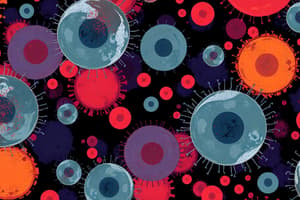Podcast
Questions and Answers
What is the function of neutrophils?
What is the function of neutrophils?
- Phagocytosis of infectious agents and cellular debris (correct)
- Transport of oxygen in the blood
- Regulation of blood pressure
- Production of antibodies
Which leukocyte is most easily identified and larger than RBC?
Which leukocyte is most easily identified and larger than RBC?
- Neutrophils (correct)
- Basophils
- Eosinophils
- Heterophils
What is a common characteristic of eosinophils?
What is a common characteristic of eosinophils?
- Bi-lobed or tri-lobed nucleus
- Affinity for acidic stains in their granules (correct)
- Spherical nucleus
- Blue color cytoplasm
What is the main cause of toxic neutrophil production?
What is the main cause of toxic neutrophil production?
What is the appearance of a hyper-segmented neutrophil?
What is the appearance of a hyper-segmented neutrophil?
What does a left shift in neutrophils indicate?
What does a left shift in neutrophils indicate?
What is the function of eosinophils?
What is the function of eosinophils?
What does neutrophilia refer to?
What does neutrophilia refer to?
What is the characteristic feature of basophils?
What is the characteristic feature of basophils?
What does a right shift in neutrophils indicate?
What does a right shift in neutrophils indicate?
What is the characteristic feature of heterophils?
What is the characteristic feature of heterophils?
What is a common cause of neutropenia?
What is a common cause of neutropenia?
Flashcards are hidden until you start studying
Study Notes
Neutrophil Functions and Characteristics
- Neutrophils play a crucial role in the innate immune response by combating infections, particularly bacterial pathogens.
- They are the most abundant type of white blood cells, making up 55-70% of total leukocytes.
- Toxic neutrophil production is often caused by severe infections, inflammation, or stress.
Easy Identification of Leukocytes
- Neutrophils, the most easily identifiable leukocyte, are larger than red blood cells (RBCs) and possess a multi-lobed nucleus.
Eosinophil Characteristics and Functions
- Eosinophils are characterized by large granules that stain orange-red with eosin dye.
- They primarily target parasitic infections and play a role in allergic responses.
Neutrophil Appearance and Indicators
- Hyper-segmented neutrophils exhibit an increased number of lobes in the nucleus, with five or more lobes, often indicating megaloblastic anemia.
- A left shift in neutrophils indicates an increased number of immature neutrophils in circulation, typically associated with acute infections or stress.
Neutrophilia and Right Shift
- Neutrophilia refers to an elevated neutrophil count in response to infections or inflammatory conditions.
- A right shift in neutrophils signifies an increase in mature neutrophils and is often associated with chronic infections or steroid use.
Basophils and Heterophils
- Basophils are characterized by large granules that stain dark blue or purple, containing histamine and heparin, and are involved in allergic responses.
- Heterophils, found in some species (like birds and reptiles), have a distinctive appearance, with a segmented nucleus and granules that are similar to mammalian neutrophils but differ in size and staining characteristics.
Neutropenia Causes
- Neutropenia, or low neutrophil count, can commonly result from conditions such as bone marrow disorders, autoimmune diseases, or the effects of chemotherapy.
Studying That Suits You
Use AI to generate personalized quizzes and flashcards to suit your learning preferences.




